Wood Stoves & Global Warming
Danny | 19.11.2007 16:06 | Ecology | Technology
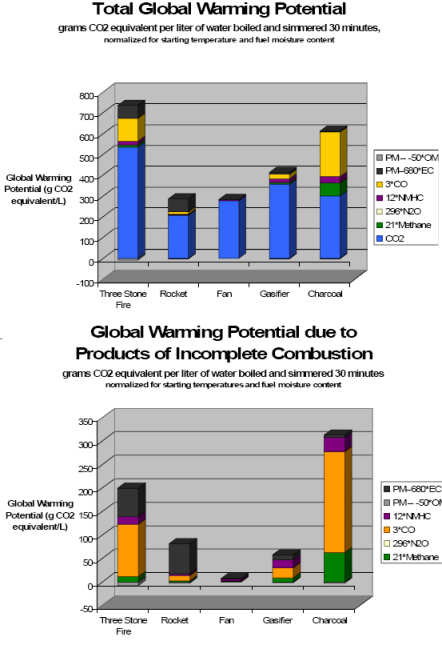
Global Waming Impact by Stove Design
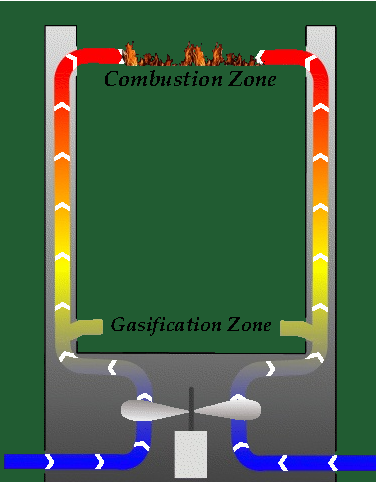
Fan Stove Operation
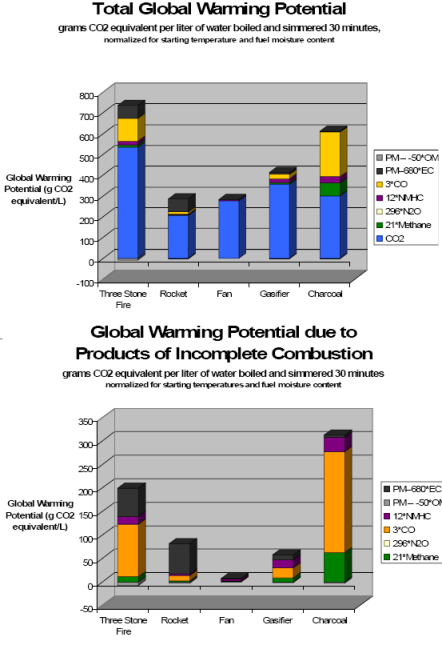
Global Warming by Stove-type
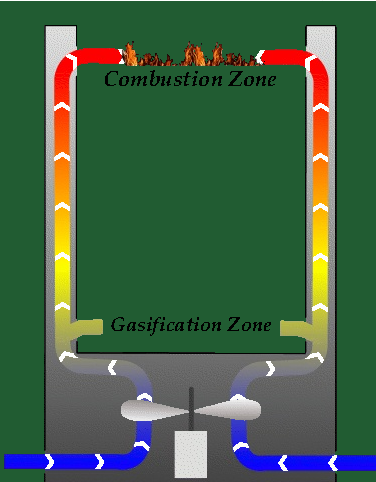
Fan Stove principle
Fan stoves drive air up through the combustion stage, but also drive air heated by the stove back into the stove as air jets which combust the various gases that normally escape from an open wood fire. Even small stoves can reach temperatures in excess of 1000 celsius. These various gases are all more potent greenhouse gases than carbon dioxide, and only the fan stoves combust them. The stove that popularised fan stoves was the small Sierra Zip camping stove which is no longer produced. It received regularly excellent reviews as a camping stove capable of gas stove temperatures without the need to carry fuel - even twigs and leaves could fuel it. A slightly larger camping fan stove is the WoodGas burner, but it still fits in a backpack [2]. The small fan at the base of the stove can be powered by a battery or a solar cell. The fan stove used in the global warming report is a prototype from Philips, a slightly larger rip-off of the Wood Gas stove [3]. It does have one rather amazing new feature though, it has a thermoelectric generator using the heat from the burning wood to generate electricity for the fan - and this power can also feed LED lighting, radios, recharge batteries etc.
A thermoelectric generator produces an electric current from heat differences, like an electronic turbine but without moving parts. It is a solid state array of N and P type semiconductor material such as bismuth telluride. It is quite inefficent but placing one next to any heat source that was being fully utilised, such as built into the chimney of a stove, provides electrical power where none exists. You don't need a special stove to produce electricity, although these devices are new to the market and you may need to build your own kit. [4]
After playing around with different designs of stove, I know it is possible to mix and match the design principles - for instance a 'rocket-fan stove' if you will. I can't make a better stove than the Philips prototype yet but it isn't avilable for purchase either. I did learn one tip for supercharging the fan stoves. If you wrap spirals of 'fire rope' around the inner container then you can channel, slow down the air destined for the combustion zone. This makes the air hotter at that stage and greatly increases combustion stage temperature, thus reducing pollutants.
[1]
 http://www.aprovecho.org/web-content/publications/assets/Global_warming_summ_9-6-07.pdf
http://www.aprovecho.org/web-content/publications/assets/Global_warming_summ_9-6-07.pdf [2]
 http://www.woodgas-stove.com
http://www.woodgas-stove.com [3]
 http://www.research.philips.com/newscenter/archive/2006/060227-woodstove.html
http://www.research.philips.com/newscenter/archive/2006/060227-woodstove.html [4]
 http://www.crest.org/discussiongroups/resources/stoves/ethos/mastbergen/Mastbergen_ETHOS_2005.pdf
http://www.crest.org/discussiongroups/resources/stoves/ethos/mastbergen/Mastbergen_ETHOS_2005.pdf
Danny
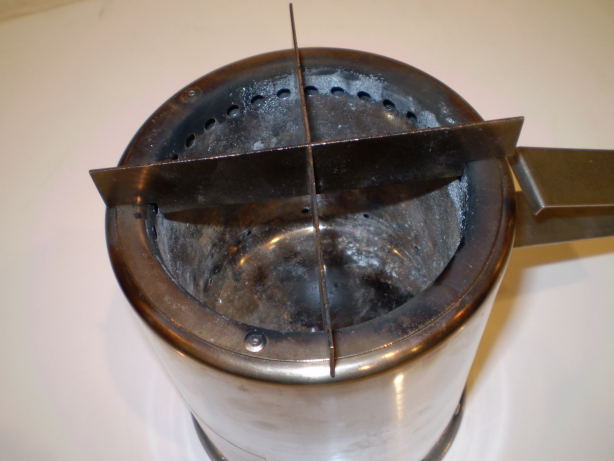
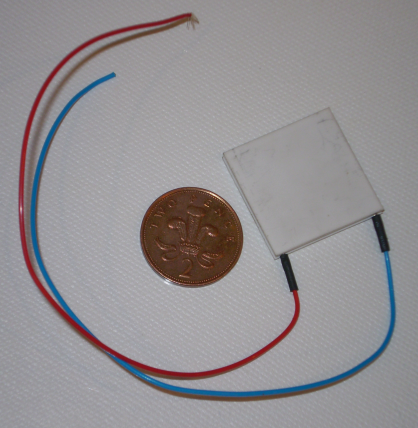
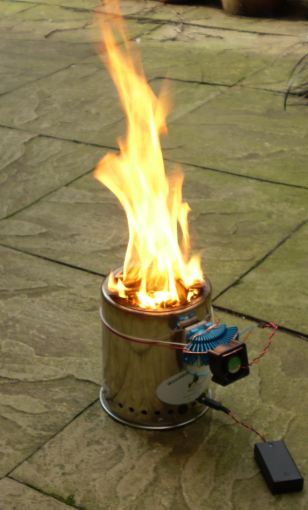
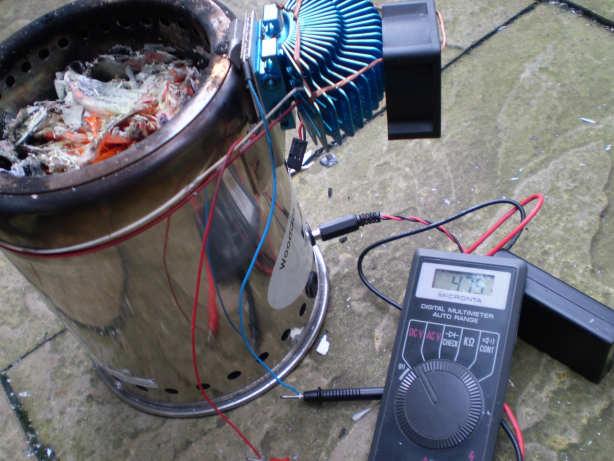
Comments
Hide the following 19 comments
Carbon neutral
19.11.2007 16:47
Mike
Carbon dioxide equivalent neutral
19.11.2007 17:32
I'm afraid, strictly speaking you are incorrect. You are making the common mistake of assuming the carbon cycle deals with all other greenhouse gases produced by combustion. It's an easy mistake to make since all greenhouse gases are simplified into their carbon-dioxide equivalence to show their 'footprint'. Where as carbon dioxide is the only greenhouse gas actually absobed by growing trees as far as I know.
The phrase 'carbon neutral' is a confusing simplification. Carbon dioxide isn't the only greenhouse gas - in fact it is one of the less damaging ones for a given quantity even though it is one the most prevalent factors overall. Tree and other carbon absobing biomass lifecycles can be rightly considered 'carbon neutral' fuel through it's lifecycle, this is not the same as being 'global warming' neutral. Burning a log gives off gases that cannot be abosrbed by forest 'sinks'. The term 'carbon footprint' is used both to refer to not only to the actual amount of carbon dioxide, but also should include the equivalent amount of global warming caused by secondary emissions. The damage caused by these secondary emissions are often converted by a 'carbon equivalent' factor to the total amount of global warming..
The rocket stove design cuts carbon emissions significantly. The fan stove also cuts emissions of other gases too. Combining these technologies, and any useful idea that works, should be a priority for anyone who understands both peak oil and climate change.
Suggesting if you grow a tree, and then burn it, that that has no negative impact on global warming is simply false, a fallacy that is leading many environmentalists to bad science akin to the promotion of biofuels as green technology a few years ago. I have been on permaculture or woodland camps supposedly concerned with the environment where open fires are used many times a day. This is crazy. I've been on peace sites where the 'wood run', collecting wood, is one of the major daily tasks, this is unneccessary and damaging both personally and globally.
Danny
Hmmm
19.11.2007 20:46
one thing we have done though is gone vegan, which reduces your impact on the planet more than anything else.
So why don't you middle class hippies just go vegan instead of moaning about everything else, whilst out driving your cars and trying to be radical with all these statistics and essays most people don't even understand.
Working Class
but is a good fire better than a bad stove?
19.11.2007 21:14
Also, there won't always be someone who has an efficient woodstove in their pack. So knowing what the best kind of woodstove is, should be complimented by knowing what the best type of wood to collect, how to find dry wood in a wet forest, what kind of fire to build to get the most efficient burn, how to start it with minimum effort and materials (Top tip: A few drops of candlewax make it a hell of a lot easier to start any fire.) I don't have the answers here, just questions.
Also, the idea that open fires are not as efficient as the best woodstoves shouldn't be confused with saying open fire bad, woodstove good. The typical metal-box type woodstove can give a very dirty burn, especially if oxygen intake is limited by closing the vents. On the other hand, most open fireplaces are also very inefficient, although there is a type called a "Rumford" fireplace that is supposed to be as efficient as a woodstove. However we had one that certainly didn't produce a clean burn, in fact it filled the cabin with smoke when the wind was in the wrong direction.
In fact, since most woodstoves are used indoors (permaculturists live in houses too), it would be very useful to know about types of efficient woodstove that are designed for indoor use, and which are available on a limited budget.
When you get down to it, political autonomy is dependent on energy autonomy, and it's hard to find a better source of energy autonomy (in temperate regions) than wood. So knowing how to burn wood cleanly and efficiently is important for any political activist.
emigre
Stovies
19.11.2007 22:31
Are you saying the working class are so stupid that they can't understand engineering or the basic principles of fire starting ? Cos I'm half working class and I take exception to that, knowing the history of great working class British engineers. My great grandpa was a rivetor on the Forth Road Bridge who warmed his rivets to a high temperature using a fan stove type design. He never had a day in school but he could build a better stove than you can, plus he understood why he needed to. The oldest rocket stove design I can find was used as a campfire by indigenous north american 'indians' which predates Columbus. The point of my article is standard tried and tested technologies can be boosted greatly by relatively modern technologies.
"There's something about sitting in a circle round an open fire...Not at all the same as sitting around a small stainless steel box."
True, thanks Emigre. Sitting around an open woodfire is romantic, it is also amazingly carcinogenic and generally unhealthy, and damaging to the environment. There is nothing nicer than kissing your true love in a cloud of campfire smoke, but if you do this regularly then it is probably chronic obstructive pulmonary disease that has taken your breath away.
"Also, there won't always be someone who has an efficient woodstove in their pack."
True but you have to be that person, or be the person who can fashion a stove out of handy materials. The simplest rocket stove is simply two metal tubes, and any open fire burns better when enclosed properly, there is no excuse for not using a closed fire except romance. Here is a link to the simplest rocket stove design :
"So knowing what the best kind of woodstove is, should be complimented by knowing what the best type of wood to collect, how to find dry wood in a wet forest, what kind of fire to build to get the most efficient burn, how to start it with minimum effort and materials. Top tip: A few drops of candlewax make it a hell of a lot easier to start any fire.) I don't have the answers here, just questions."
I was limiting myself to stoves but you are quite right, other techniques are important too. My top tip for saving energy when cooking would be using a 'haybox' for cooking - an insulted box or sack where a heated pot or pan can be placed to retain heat while the cooking process completes without fuel. Or an alternative tip to start a fire in harsh conditions, a cottonball dipped in vaseline. However, the fan stoves I am describing are not dependent on any partcular type of fuel - yes, sawdust based wood pellets are amazingly easy to use and full of heat, but they work perfectly well with wet twigs, leaves, grass, and even manure.
"When you get down to it, political autonomy is dependent on energy autonomy, and it's hard to find a better source of energy autonomy (in temperate regions) than wood. So knowing how to burn wood cleanly and efficiently is important for any political activist."
Exactly, though more than that, biomass is the only fuel available to most of humanity. This may seem an over the top claim in the West given the petroleum we consume, but the technology isn't limited to cooking fires. Apart from Rocket stoves, there are rocket ovens, rocket lanterns etc, and over a million vehicles were powered by fan-stove type gasifiers during world war two.
Oil is an evolutionary dead-end - it is time we reversed away from that cul-de-sac. Being able to go for a walk, stop for five minutes, produce a hot meal and electricity from whatever is lying around is a great boon to anyone.
Danny
working class heros
20.11.2007 14:29
Wood stoves are nice and people should have more of them regards of the fuking carbon. Heres the best one I've found. The price tag is horrific though and they are a new product so no second hand - but it looks to me like the ultimate ideal stove:
joe blogs
working class my ass
20.11.2007 14:56
So why the fuck should anyone be ashamed of having the resources and the inclination to try and do something against the unjust and world-destroying capitalist megamachine? What's shameful is the 99% of the global middle class who know about the shit state of the world and do sod all about it. So say it now and say it loud, "I'm a middle class anarchist and I'm proud."
emigre
Joe
20.11.2007 16:22
"but it looks to me like the ultimate ideal stove"
It is a lovely bit of furniture and I'm sure it will heat a room, but it looks a crap stove. I mean the clue is in the webpage you linked to "We do not recommend that the Ironheart is used as a primary cooking appliance". A stove is a primary cooking appliance. The bulkier and more metal a stove is, the more it radiates it's cooking heat away and the more fuel it has to consume to get the stove at the right temperature. I can cook better on the £30 WoodGas stove than you would be able to on that beast - I would use less wood and maintain a much higher temperature. I can build a better stove out of tin cans and fireclay that the Esse. Plus I can put my stove in a bag and carry it with me, and find fuel for it effortlessly anywhere. It doesn't look pretty and it doesn't warm a group of people up, it cooks. What makes a good stove makes a bad heater, and vice versa. Hybrid cooker/ heater/ boilers ( or ranges ) generally are at best adequate at one of their roles.
So it depends on what you want from a stove, one design does not fit all needs. If you want a clean, efficent, portable, hot, cheap and miserly device to cook food and heat water, go for the WoodGas fan stove. If you want a beautiful yet useless conversation piece that would be good to have sex in front of, go for the Esse. To be honest I don't imagine I'll seduce anyone with the WoodGas fan stove. It is no more sexy than a paint can.
Even if you have a crap old stove like the Esse, you can make it more efficent. Fill the three cavities, and all around the range, with insulating material that can cope with the temperatures. Line the entire combustion chamber with sealed, high quality fire bricks. And know, if you are operating anything warm, you can now generate hassle-free, cost-free electricity by using thermoelectric kits. Thermoelectrics is brand new technology but it is so useful it's bound to be universally adopted in no time.
Danny
enough of this irrelevant class crap
20.11.2007 19:12
dave
make firecob, not phoney class war
20.11.2007 21:16
Not sure I agree with that. What makes a good wood burner is efficient combustion, with hot "secondary" combustion of the smoke to extract the maximum energy and emit the minimum of toxics / particulates / greenhouse gases.
After that, what you do with the heat depends on what you want it for. You can use it to cook (like in the woodgas stove), to heat your house (like a good masonry stove does) or to heat water, etc. - or even as a neoprimitive TV substitute (actually, if you think about it, TV is a fucking poor substitute for a campfire). If you need to and you have the right kind of stove then I don't see why you shouldn't be able to do these tasks simultaneously or alternately. Now that would be a high class stove.
By the way, don't waste your money on fire bricks unless your stove lining is going to be taking knocks from firewood, etc. Cob (a mixture of 20% clay and up to 80% coarse sand, sometimes with fibres added, though not in high-temperature uses) does the thermal mass job just as well or better, is totally fireproof and costs virtually nothing.
emigre
Emigre
21.11.2007 01:07
Yeah, and it would be nice if your cooker also refrigerated food, or your refrigerator heated your pizza, but they are fundamentally opposite tasks. The only thing an efficent wood burning heater and an efficent wood burning cooker have in common is the fuel. A heater is a big lump of metal that radiates heat over as wide a distance as possible. A cooker focuses heat and radiates as little energy as possible. Cooker = light, heater = heavy. Cooker = insulated, heater = conductive. I strongly recommend you specialise designs rather than compromise these opposite design demands. Believe me, I had a Rayburn for 12 years heating my house and I had to fill it with fuel anytime I wanted a hot bath or a meal, plus it filled the house with thick smoke.
"Cob (a mixture of 20% clay and up to 80% coarse sand, sometimes with fibres added, though not in high-temperature uses) does the thermal mass job just as well or better, is totally fireproof and costs virtually nothing."
Cob is too heavy for me, albeit you can make it anywhere with clay soil. I have tested different insulators and heavily favour a vermiculite mix. Make your cob, add one part vermiculite for two parts cob, and your cooker is half it's mass. There is also some liquid you can buy that increases the combustion temperature of just about anything. You should bear in mind with a range or any device that I've seen that acts both as heater and cooker, it will reach a temperture of about 500-750 celsius, where as rocket stoves and fan stoves are more like mini-forges, they can reach double that temperature. So something that is good insulation for one design is not necessarily safe for another. I am finding out what works by trial and error - supercharging stoves and seeing if they melt or ignite. The biggest danger in testing stoves to the limit - well, apart from burning yourself - is the heavy metals that some metals give off at high temperature.
I don't actually use any clay but this is worth a read :
Making Insulative Clay Combustion Chambers
However you must be a bit psychic cos I am hoping to build a couple of wooden framed cob bothies come Spring as hideaways. I've never worked with cob and so probably will need your advice about it by then. I want to make a cob geodesic dome too, just because I haven't heard of anyone who has and I'm curious if it survives the weather.
I've got some pictures of standard peace-camp burners built out of large, old gas canisters. Another time I'll post the pictures here, and I will post a design for a quick, cheap upgrade that'll half the amount of fuel required. I'll need to build one to test this first though.
Danny
facinating stuff ...
22.11.2007 09:25
The ones that I just cut and crudely punched holes in are good for outside only ... can still cook a tasty suasage on it though (veggie of course!) ... or even a well planned curry.
Would love to see more pics and hear more design tips/scavanging suggestions etc ... also, Danny, what info on this thermo-electrics? Is it a useable technology?
This year I'm asking santa for a storm kettle.
jackslucid
 e-mail:
jackslucid@hotmail.com
e-mail:
jackslucid@hotmail.com
Thermoelectrics
22.11.2007 12:33
Kerosene lamp for powering 1950's radio
I was wrong to say thermoelectrics are a new technology, it's more of a forgotten technology.
Go onto RS components and search for thermoelctric and you'll find a host of kits and parts. It seems great for providing power if you have any heat source. I've just ordered my first devices though so I'll need to play around with it first.
Danny
 Homepage:
http://www.dself.dsl.pipex.com/MUSEUM/POWER/thermoelectric/thermoelectric.htm
Homepage:
http://www.dself.dsl.pipex.com/MUSEUM/POWER/thermoelectric/thermoelectric.htm
My favourite things
04.02.2008 03:12
The second photo is a thermoelectric device, next to a coin for scale. It produces up to 15 volts at 38 watts when one side of the device is 75 celsius warmer than the other side. This is far more power from a far smaller device - and a lower cost - than any solar cell , though the device itself is only about 4% efficent and does rely on a high temperature source of waste heat. The most common current use of thermoelectric devices is to cool and heat the 'picnic chill boxes' that rich people keep their beer in on sunny days. These are the environmental equivalent of porch heaters. Realise that to heat a space using battery power is more expensive, and more environmentally damaging, than burning pound notes. To cool or warm a space using thermoelectrics is more expensive than burning twenty pound notes. These are dastardly devices when they are powered to achieve a temperature change. It is only when they are used to produce electrical power from a temperature difference that they become saintly / sane.
The third and fourth photos are me trying to mix these two wonderful things to produce an efficent, healthy and sustainable way to cook and heat water plus produce sizable amounts of electricity at the same time. The maximum temperature of the thermoelectric device is 150 celsius which makes the position of he device critical - not hot enough, or if you can't cool the other side enough, and you get no useful power from it. The design of the stove ensures the external body rarely gets very hot except at the very top where it can approach 150 celsius. To place the thermoelectric device at the top ensures it is licked by flames far hotter than it can withstand. It is a bugger of a problem.
My next step is to try to hermetically seal the thermoelectric device, and it's cooling system, inside the frame of the stove, so that the temperature balance is achieved. I can't risk trying that just now as I may break my stove trying, and I sort of need it to survive until spring. Oh, while all this is something I thought up for myself, I found the Phillips corporation have already developed a wood fan stove with a thermoelctric device built in. It isn't on the market yet, and mine will be more functional when I catch up with them, without infringing their patents but they've been developing theirs for years and have a bigger R&D budget than I do.
As to Daves "get off your lazy arse and actually do something useful like knock up some stoves using old gas bottles or cooking oil tins and then flog them to the middle classes that you so despise and you can fleece them in the process" - well, I fully agree. If I can get to market before Phillips can, then I will sell these for a hefty profit to Western activists, climbers, campers and cub-scouts. I'll plough any profit into providing subsidised versions of the stove to the people who really need it, the Indians and Africans who are dying from smoke inhalation from open fires and who have no electricity.
Danny
More stuff
04.02.2008 15:07
Pinoccio
Carbon Neutral - as if by magic
07.02.2008 12:45
There is no way that growing a tree and then cutting it down and burning it is envirnonmentally neutral even if it is supposedly carbon neutral. Apart from anything else you have the radiated heat, and let's ignore the fact that carbon gases aren't the only greenhouse gases. The easiest test the truth of an argument at the extremes so indulge me - if tommorow we burned every tree and forest then that would be 'carbon neutral' as they were all going to die and release their carbon anyway. However it would be damn hot, be bad for the climate and would end most life on earth quickly.
It is better to use less wood more efficently, to extend the life of all living trees. Harvesting trees industrially causes soil damage releasing carbon, uses petrol vehicles directly and indirectly for transportation of product and workers, and if planted in an area that is snowy in winter all conifer forests contribute to global warming by absobing more heat than reflective snow.
I'd rather see each home equipped ith a woodburning stove which provides the house it's electricity too. That way you have fewer big powerstations of any flavour. A home stove generator doesn't have to be as efficent as a large power station can be, as there are none of the transmission losses or staff and equipment overheads.
The reality is most people who are cooking from woodpower are cooking over open fires, which is bad for them and bad for everyone else. Sometimes they do this for heat, sometimes for light, sometimes for lack of knowledge or acces to a stove. Four bit's of sheet metal able to be slotted together could save millions of lives.
I strongly believe in a fusion of hi-tech and lo-tech but I feel some pseudo-scientific gargon should be dropped. Is it meaningful to define 'carbon footprints' in terms that although us to compare the G8 Conference to the Sea Sheperd ? It's not just fuel expended, it i intent.
Can anyone imagine a carbon neutral molotov cocktail ? With peak oil prices there are cheaper weapons nowadays. The G8 conference at Gleneagles. was 'carbon neutral' as they paid someone to plant some trees to offset the direct climate costs of their travel. Do you remember the headlines ? "G8 Carbon neutral". As if all the G8 countries weren't the biggest polluters. As if. If someone had burned the Gleneagles conference down, that too technically would have been carbon neutral by the normal definition, except for any accelerant that was used. As if.
Here is a good, brief, article about woodstove design and testing - will I see some of you at Stove Camp 2009 ?:
Danny
Oil consumption, renewables & thermoelectrics
08.02.2008 12:14
“Even at the current efficiencies of thermoelectric devices, 7 to 8 percent, more than 1.5 billion gallons of diesel could be saved each year in the U.S. if thermoelectric generators were used on the exhaust of heavy trucks. That translates into billions of dollars saved” - Prof. Tritt of Clemson University. [3]
The use of thermoelectrics doesn't just mitigate fossil fuel use, it also can be used with true renewables like photovoltiacs. Someone claimed last month to have a combined device that converts the suns energy at 60 efficiency, which is twice as efficent as any previous solar generator [4].
I'm playing with thermoelectrics in fan stoves simply because I am interested in stoves.
The obvious disadvantage of fan stoves is having to power the fan. Some manufacturers provided solar cells to power the fan, which is useless without sunlight. I modified a mobile phone solar charger with a built in battery to power the fan but it takes all day to charge up. Using a thermoelectric device to directly replace the battery isn't a good idea, as it will only turn the fan when the fire is already hot. Instead, the fan should start using batteries and then switch to the thermoelectric device, using a pot. dial to vary fan speed. The device will both power the fan and recharge the battery, and should be able to provide enough excess power to an external devices at various voltages like a battery charger, LED lights, a radio or whatever.
[1]
[2]
[3]
[4]
Danny
my woodstoves
24.02.2008 10:49
They burn smokefree because of a patented design feature which preheats the incoming air and it enters the firebox through tiny holes creating jets of very hot fresh air, and lots of turbulence. This is 85% efficient (compared to 15% efficient for open fires).
I cook on the flat top, and heat bathwater, washing up water, and make dried fruit from thrown-away fruit from a greengrocer.
I understand the comments about other climate change gases from combustion (oxides of nitrogen mainly) but if this renewable fuel replaces fossil fuel, it's gotta be good, as the fossil fuel combustion would make similar NOx gases.
I source my logs locally from urban tree pruning/felling, and nearly all are brought home in my cycle trailer. Occasionally a petrol-head drops some off for me... I think it would be churlish to refuse!!!! I cut them up mainly by hand (bowsaw) and split them mainly with an axe, although I have electrically powered equipment to do this if I wanted to (leccy from Good Energy though...)
So I love woodstoves as a way of keeping your carbon footprint low, keeping healthy from the exercise, and the aesthetics of them too.
John Cossham, York
John Cossham
Heating vs Cooking
27.02.2008 13:00
KachelOven
That is also how my little fan stove work too, as the air is circulated around the outside of the stove it is preheated. Clearview will doubtless patent their designs, but the concept isn't patentable and so any of us can experiment with it. According to wikipedia "A stove is an appliance that may be used for heating, cooking or both. Stoves differ from open fires in that they are easier to control, more efficient and may create less pollution". Your Clearview stoves are primarily heating devices, my woodstove is solely a cooking device, but they employ the same principle. However the design of a cooking stove is quite different from a heating stove. Heating stoves are as heavy as possible, and conduct as much heat as possible, directly or though radiators. Cooking stoves are as light and insulated as possible, and focus the heat on a small area. Most domestic stoves are dual purpose or primarily heating devices. The photo is an example of a widely used Scandavian thermal mass firestove, the Kacheloven. It is solely for heating and is generally only lit once or twice a day. If you are prepared to have two stoves in the house though, I'd recommend one designed for solely heating and one solely for cooking.
So well done John, you undoubtedly have a lower carbon footprint than me, especially for following the prime rule of not cutting down live trees for fuel. The stoves I am most interested in are most suitable in for third-world countries as a replacement for open fires and less efficient stoves for cooking, mainly due to the health effects of smoke inhalation, partly due to the possible reduction of tropical deforestation. They also work well for activists and campers. When I say that wood isn't carbon neutral as a fuel, I still acknowledge that the more people in the West who follow your example would be a greater impact on climate change than all the poor in the world suddenly becoming more fuel efficient. And it isn't a matter of conserving fossil fuels, other people will consume them anyway, it is what happens after they inevitably disappear.
My posts have mixed up the subjects of woodstoves and thermoelectrics. Generating electricity from thermoelectric devices is even easier on stoves like John has, and from what he has said I expect he'd like to be freed from the grid if he isn't already. To be honest, you probably won't get 38 watts out of a device like I bought, probably half that, but if you could afford to cover the stove with them then you could generate more electricity than you use - and the more people who buy them the cheaper they will become, it is not new or complicated technology. This is great for western houses, but I think it is more important to focus on how vital it can be for the mass of humanity who currently use open fires and have no access to affordable electricity.
Danny